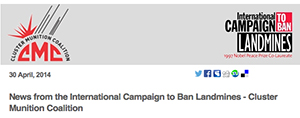22 June 2010
ICBL Statement on a Mine-Free Central America
Standing Committee on Mine Clearance, Mine Risk Education and Mine Action Technologies, 22 June 2010, Delivered by Megan Burke, Landmine and Cluster Munition Monitor. We would like to congratulate Nicaragua on meeting its Article 5 mine clearance obligations. Nicaragua's declaration of completion makes Central America the world's first landmine-free region. North and Central America, from the Arctic Circle to the Colombian border, are now free from the threat of landmines.
This success demonstrates that with sustained efforts a mine-free world is possible. Communities throughout Central America that suffered from conflict in recent history are now free from the threat of mines and can move on with rebuilding their lives. As Central America emerged from conflict, over a decade of mine clearance served as a regional confidence-building measure and embodied the Mine Ban Treaty's spirit of openness, transparency, and cooperation.
Central American governments, the Organization of American States (OAS), and international donors showed significant political will and demonstrated the importance of international cooperation and assistance in mine action. The job is not done now that mine areas have been cleared. Residual mine clearance capacity will still be needed as there are still likely mines in weapons caches or emplaced in unknown areas. Landmine survivors, their families, and communities require lifelong assistance. National governments and international donors are now in a position to redirect funds previously used to support clearance into victim assistance initiatives, and to show Central American leadership on victim assistance programming.
Since the wars of the 1980s, mines and other explosive remnants of war have caused an estimated 5,000 casualties in Central America, with most of these in El Salvador and Nicaragua. While many survivors have received assistance to some extent, thanks to both national and international support, a 2009 study found that the vast majority of survivors continue to be isolated and lack jobs. With reinforced political commitment and financial support from donor states, we could soon reach the goal of a mine-free Americas that the OAS has called for since 1996. Now that clearance is finished in Central America, hopefully more focus can be put on Colombia, the most affected country in the Americas and one of the most affected in the world.
Thank you.


